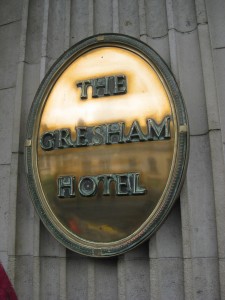Map of Major Sites in Dublin
Restaurants and Services in the Vicinity of Ariel House Hotel
More Information
Trinity College and the Parliament House (Bank of Ireland)
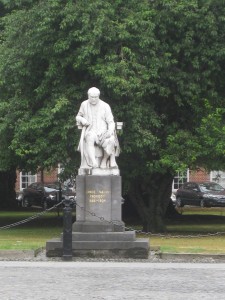
Trinity College was established by a royal charter in 1592. It was believed that establishing a university was a quintessential step in Ireland’s development. In comparison, England at the time had two major universities (Cambridge and Oxford) and Scotland had four. Today, the college occupies forty-seven acres, and serves over twelve thousand undergraduate students and almost five thousand postgraduate students. The Library of Trinity College contains over 4.5 million books or volumes, including the Book of Kells.
John Kavanagh Pub
John O’Neill converted part of his home into this pub in 1833, a year after the Glasnevin Cemetery opened. The pub is widely known as “The Grave Diggers,” a nickname coined by the works at Glasnevin in the 1970s.
Guinness Brewery
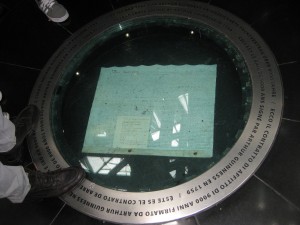
Arthur Guinness (1725-1803) is the founder of the Guinness company. He used money left to him by his godfather, Dr. Arthur Price, to start his own brewery in Leixlip in 1755 wherehe brewed ale. In 1759, he left this brewery to one of his brothers and went to Dublin. In Dublin, he joined the Dublin Brewers and Maltsters Corporation and signed a lease for St. James’ Gate, a small, rundown brewery sitting on 4 acres, the current location of the brewery. The lease was for 9000 years with a rent of 45 pounds annually, which is roughly 70 American dollars by today’s standards. However, the lease is no longer in effect because the brewery has been expanded. By 1838, Guinness was the largest brewery in the country.
The National Library & Yeats Exhibit
The National Library of Ireland was established by the Dublin Science and Art Museum Act in 1877. The same act provided the bulk of collections owned by the Royal Dublin Society.
The exhibition, Yeats: The Life and Works of William Butler Yeats, opened to acclaim on May 25, 2006. More than a quarter of a million people have visited.
Merrion Square
Laid out in 1762 and complete by the beginning of the 19th century, the Merrion is considered one of the city’s finest squares. Three sides of the square are lined with townhouses, of which many have plaques providing historical information on famous former residents, such as W.B. Yeats who lived in No. 82. The West side shares a boundary with the grounds of Leinster House, Government Buildings, the Natural History Museum, and the National Gallery. The garden has been converted into a public park.
National Gallery

Designed by Francis Fowke and completed in 1864 based on enthusiasm of the crowd during the Great Industrial Exhibition held on the lawns of Leinster House in 1853. Admission to the Gallery is free and operating hours are 9:30am-5:30pm Monday-Saturday, 9:30am-8:30pm Thursday, and 12pm-5:30pm Sunday.
St. Stephen’s Green
St. Stephen’s Green is a public park in Dublin which officially opened to the public on July 27, 1880. It is the largest of the parks in Dublin’s main Georgian garden squares at 22 acres. The landscape was designed by William Sheppard. The park is adjacent to Grafton Street, one of Dublin’s main shopping streets.
Grafton Street
One of the two principle shopping streets in Dublin city center, running from St. Stephen’s Green to College Green.
The Archaeology Museum
The Archaeology Museum is a part of The National Museum of Ireland which was founded in 1877. The Museum is free and open to visitors Tuesday – Saturday from 2 p.m. until 5 p.m. and on Sunday from 2 p.m. until 5 p.m. Noteworthy exhibits include Viking Ireland, Life and Death in the Roman World, Ireland’s Gold, Prehistoric Ireland, and Kingship & Sacrifice. They even have an Ancient Egypt and Ancient Cyprus collection.
Baily Lighthouse on Howth Head
Located on the southeastern part of Howth Head in Dublin. The top of the tower stands at 134 feet above the sea. The area has been the scene of many shipwrecks. Particularly notable is the February 15, 1853 wreck of the PS Queen Victoria in which over 80 passengers and crew died. A fog bell was installed in April, 1853 as a result.
Dublin Writers’ Museum
Located in Parnell Square, the Dublin Writers’ Museum was opened in November of 1991. The mission of the museum is to give visitors an overview of over three hundred years of Irish literature and its writers.
Originally called The Municipal Gallery of Modern Art and the topic of Yeats’ “To a Wealthy Man who promised a second Subscription to the Dublin Municipal Gallery if it were proved the People wanted Pictures.” An art gallery funded by Dublin City Council and located in the Charlemont House. The gallery was founded by Hugh Lane in 1908 on Harcourt Street, but has since by relocated to Parnell Square. It is the first known public gallery of modern art in the world.
The Gresham Hotel
The Gresham Hotel is a four star hotel located in Dublin. It is featured in James Joyce’s Dubliners.
Davy Byrnes
Pub made famous by James Joyce’s Ulysses. Joyce also mentions the pub in his short story “Counterparts” from Dubliners.
James Joyce Center
A museum dedicated to the life and works of JamesJoyce. On permanent exhibition is the furniture from Paul Leon’s apartment in Paris, where Joyce wrote much of Fin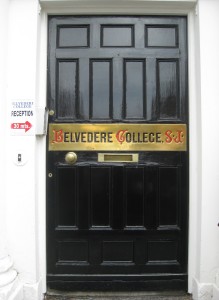 negans
negans
Wake.
Belvedere College
A private Jesuit secondary school for boys that currently has 1005 enrolled students. The school is the alma mater of Stephen Dedalus, of Joyce’s A Portrait of the Artist as a Young Man.
Christ Church Cathedral
For most of the history of Christ Church and St. Patrick’s Cathedral, both held the status of cathedral for the Dublin diocese, an arrangement that ended due to the move to disestablish the Church of Ireland. The Archbishop of Dublin has his seat in this Cathedral.
St. Patrick’s Cathedral
Founded in 1191 and the largest church in Ireland.
Sandy Cove
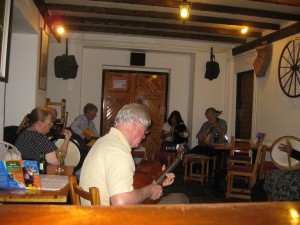
A Martello tower in Sandycove where Joyce spent six nights in 1904. Joyce left after an incident in which Gogarty fired a gun in his direction, now immortalised in the opening scenes of Ulysses. The tower now contains a museum for Joyce and displays some of his possessions.
Comhaltas Ceoltoin Eireann
Translates to “Society of the Musicians of Ireland.” Comhaltas is the organization most dedicated to Irish music, song, dance, and language. Founded in 1951 and with more than 400 branches worldwide.
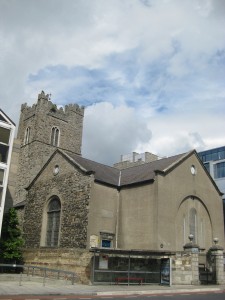
St. Michan’s Church
St. Michan’s Church is a Church of Ireland built on top of a Danish chapel in 1095, howevermost of the building is from a renovation/reconstruction in 1686. Perhaps the most noteworthy aspect of this church is the vault, which contain mummified corpses. Some of the remains include a 400 year old body if a nun and a crusader. Legend has it that it is good luck to touch the finger of the crusader. There are also bodies there from the 1798 rebellion.
The Brazen Head Pub
The Brazen Head is Ireland’s oldest pub, dating back to 1198. The pub features live music and has had a 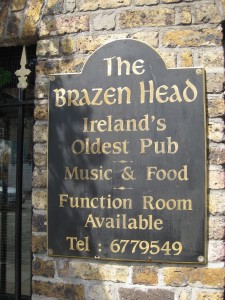 number of famous patrons such as writers James Joyce, Brendan Behan, and Jonathan Swift.
number of famous patrons such as writers James Joyce, Brendan Behan, and Jonathan Swift.
Chester Beatty Library
The original Chester Beatty Library founded in 1950 stored the collections of Sir Alfred Chester Beatty. The current or present day Chester Beatty was opened on the grounds of Dublin Castle in February of 2000. Admission is free and it is open this summer from Monday to Friday (10 a.m. to 5 p.m.), Saturday (11 a.m. to 5 p.m.), Sunday (1 p.m. to 5 p.m.). Some of the collections/exhibitions featured in the museum are the East Asian Collection, Islamic Collection, and the Western Collection.
Kilmainham Gaol
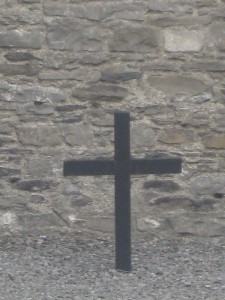
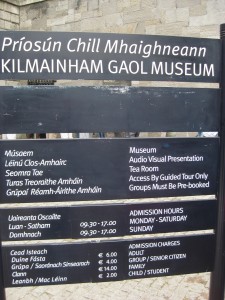 A prison first built in 1796, but now converted to museum, theKilmainham Gaol is run by the Office of Public Works. Leaders of the 1916 Easter Uprising were executed at the Gaol; on May 3rd, Patrick Pearse, Thomas Clarke, Thomas MacDonagh; on May 4th, Joseph Plunkett, Edward Daly, Michael O’Hanrahan, Willie Pearse; on May 5th, John MacBride; on May 8th, Eamonn Ceantt, Michael Mallin, Sean Heuston, Con Colbert; on May 12th, Sean MacDiarmada, James Connolly.
A prison first built in 1796, but now converted to museum, theKilmainham Gaol is run by the Office of Public Works. Leaders of the 1916 Easter Uprising were executed at the Gaol; on May 3rd, Patrick Pearse, Thomas Clarke, Thomas MacDonagh; on May 4th, Joseph Plunkett, Edward Daly, Michael O’Hanrahan, Willie Pearse; on May 5th, John MacBride; on May 8th, Eamonn Ceantt, Michael Mallin, Sean Heuston, Con Colbert; on May 12th, Sean MacDiarmada, James Connolly.
Abbey Theatre
First opened on December 27, 1904 and rebuilt in 1966 due to a fire in 1951. The theatre was closely associated with the writers of the Irish Literary Revival, of which many members were involved in its founding and housing many playwrights of the 20th century, including W.B. Yeats, Augusta Gregory, Sean O’Casey, and John Synge.
Dublin City University
Dublin City University (DCU) was founded as the National Institute for Higher Education in 1975. It obtained university status in 1989. Today, the university serves over six thousand undergraduate students and has over forty-five thousand alumni. It was also home to our 2013 SUNY Geneseo study abroad students in the Yeats Poetry class for about a week.
Government Buildings
Offices located in the building are the Department of the Taoiseach, the Council Chamber, the Office of the Attorney General, the Department of Finance, and the Department of Public Expenditure and Reform.
Statue of Molly Malone
The Molly Malone statue located on Grafton Street in Dublin city was unveiled during the 1988 Dublin Millennium celebration. Her character is feature in the unofficial song of Dublin city entitled “Molly Malone” or “In Dublin’s Fair City.” June 13th is Molly Malone Day.
Thomas Moore Statue
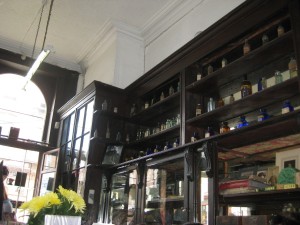
Thomas Moore was born May 28, 1779 and died February 25, 1852. He was a poet, singer, songwriter, and entertainer. He was married to Elizabeth Dyke. He is considered by some to be Ireland’s Bard and is perhaps best remembered for his lyrics of “The Minstrel Boy” and “The Last Rose of Summer.”
Sweny’s Pharmacy
Featured in James Joyce’s Ulysses. Today it is maintained by volunteers and is preserved as it was during Joyce’s life.
Garden of Remembrance
A memorial garden in Dublin dedicated to the memory of all who died fighting for Irish freedom. Located on O’Connell Street
The General Post Office
The General Post Office (GPO) is the headquarters of the Irish Post Office, but perhaps the most interesting aspect of the building’s history is its involvement in the Easter Rising of 1916. During the rising, the building was used as the headquarters for the rebel leaders and it was almost completely destroyed by a fire during the rebellion. It was reconstructed by the government of Irish Free State later on. There is a Post Museum which visitors can visit to learn more about the building’s past.
